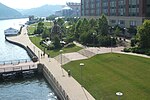Manchester Bridge (Pittsburgh)
1915 establishments in Pennsylvania1969 disestablishments in PennsylvaniaBridges completed in 1915Bridges in PittsburghBridges over the Allegheny River ... and 9 more
Buildings and structures demolished by controlled implosionBuildings and structures demolished in 1970Demolished bridges in the United StatesHistoric American Engineering Record in PennsylvaniaPennsylvania bridge (structure) stubsPittsburgh building and structure stubsPratt truss bridges in the United StatesRoad bridges in PennsylvaniaSteel bridges in the United States

The Manchester Bridge, also known as the North Side Point Bridge, was a steel Pratt truss bridge that spanned the Allegheny River in Pittsburgh, Pennsylvania.
Excerpt from the Wikipedia article Manchester Bridge (Pittsburgh) (License: CC BY-SA 3.0, Authors, Images).Manchester Bridge (Pittsburgh)
Three Rivers Heritage Trail, Pittsburgh
Geographical coordinates (GPS) Address Nearby Places Show on map
Geographical coordinates (GPS)
| Latitude | Longitude |
|---|---|
| N 40.4435 ° | E -80.0129 ° |
Address
Three Rivers Heritage Trail
Three Rivers Heritage Trail
15211 Pittsburgh
Pennsylvania, United States
Open on Google Maps







